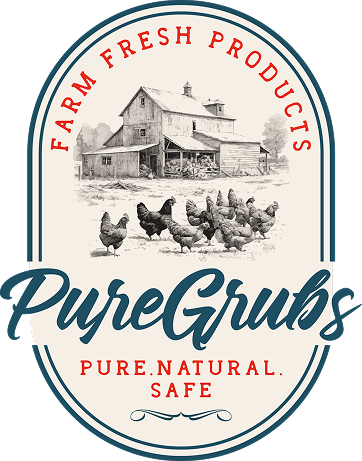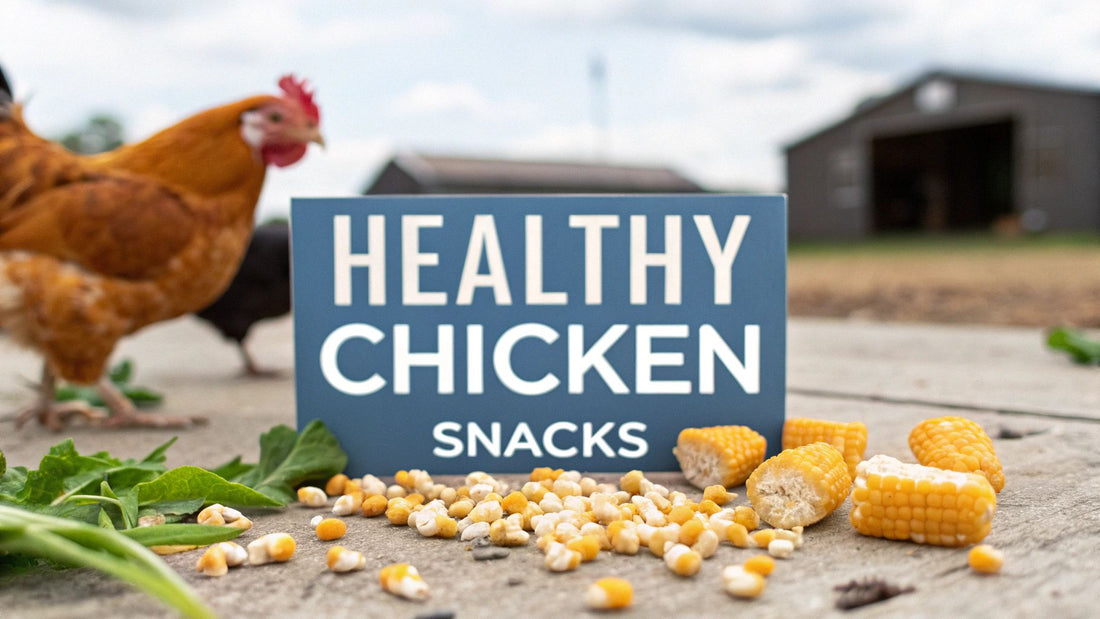
The Ultimate Guide to Healthy Snacks for Chickens
Share
When it comes to the best snacks for chickens, think natural and healthy. Leafy greens, fresh vegetables, bits of fruit, and high-protein goodies like black soldier fly larvae are fantastic choices. But remember, these are just supplements. A top-notch commercial feed should always be the cornerstone of their diet, providing the complete nutrition they need to thrive.
Why Moderation Is Key for Chicken Treats
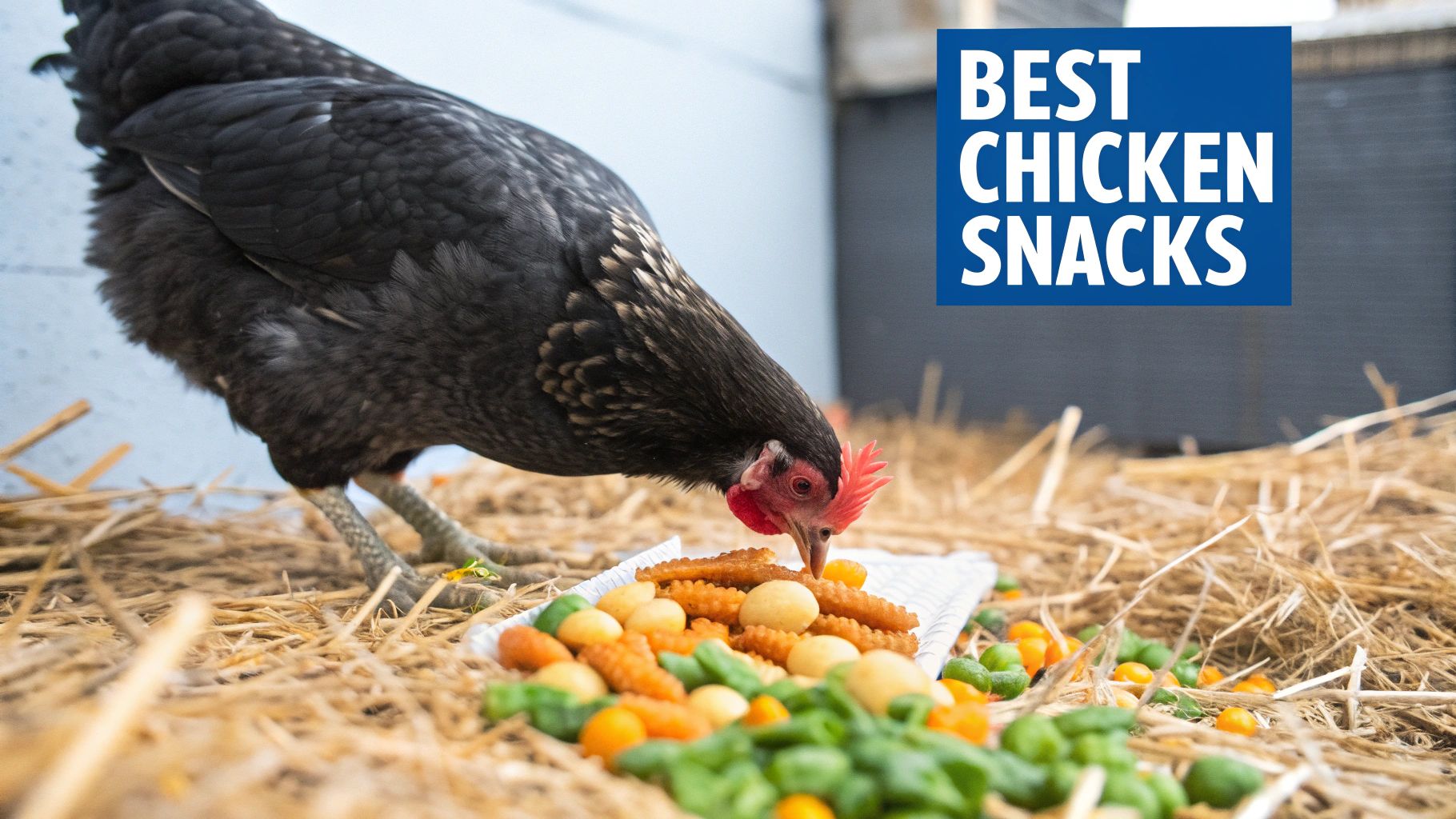
Think of your flock's diet like building a house. Their complete feed is the foundation and framework—it’s got all the structural support needed for a healthy, sturdy bird. Snacks are the fun decorations you add later. They bring a lot of joy and variety, but they can't hold the house up by themselves.
That’s why so many of us in the chicken community live by the 90/10 rule. It’s a simple guideline: 90% of your flock’s daily food should be their complete feed, and only 10% should be treats. Sticking to this ratio is the secret to keeping your chickens healthy and productive without spoiling their dinner.
The Risks of Overindulgence
It’s easy to get carried away with treats, but it can cause real problems. When chickens fill up on snacks, they don't have room for the balanced feed that provides all their essential vitamins and minerals. This can quickly lead to nutritional gaps.
You might start to see issues like poor feather quality, low energy levels, or even a weaker immune system. Worse yet, it can really mess with egg production. Laying hens need a specific amount of protein and calcium to create strong eggshells. If their diet is diluted with too many low-calcium treats, you'll often end up with soft-shelled, misshapen, or even shell-less eggs.
A classic rookie mistake is treating chickens like a walking compost bin for kitchen scraps. While some leftovers are fine, you have to be careful. Processed foods, sugary junk, and salty snacks can wreak havoc on their digestive systems and lead to nasty conditions like sour crop.
Choosing the Right Kind of Snacks
Giving your flock a treat isn't just about spoiling them; it’s about supplementing their diet in a way that truly benefits them. The best snacks offer real health perks and tap into their natural instincts, like foraging and pecking.
To help you get started, here is a quick reference table outlining some of the best—and worst—snack choices for your flock.
Quick Guide to Safe Chicken Snacks
| Snack Category | Safe Examples | Notes & Moderation |
|---|---|---|
| High-Protein Bugs | Black Soldier Fly Larvae, Mealworms | Excellent for molting. BSFL are higher in calcium. Feed a small handful per bird a few times a week. |
| Leafy Greens | Kale, Spinach, Lettuce, Swiss Chard | Great source of vitamins. Offer in moderation, as too much can cause digestive upset. |
| Vegetables | Cooked Squash, Broccoli, Carrots, Cucumbers | Chop into small, manageable pieces. Avoid raw potato peels and uncooked beans. |
| Fruits | Berries, Melon, Apples (no seeds), Bananas | Sugary, so offer sparingly. Watermelon is fantastic for hydration on hot days. |
| Grains | Scratch Grains, Oats, Cooked Rice | Best used to encourage foraging. Low in nutritional value, so treat it like "junk food." |
| Unsafe/Avoid | Avocado, Chocolate, Onions, Salty/Processed Foods | These items are toxic or unhealthy for chickens and should never be offered. |
By focusing on these healthier options, you’re doing more than just giving a treat; you’re enhancing their well-being.
The Real Benefits of Smart Snacking
The right snacks, given in moderation, can do a world of good:
- Nutritional Boost: Protein-packed treats like black soldier fly larvae are a game-changer during the fall molt, helping feathers grow back strong and glossy. If you're wondering where to buy black soldier fly larvae, they're widely available and a great high-calcium choice.
- Hydration Support: On a scorching summer day, a few chunks of watermelon or cucumber can make a big difference in keeping your flock cool and hydrated.
- Enrichment and Boredom Busting: Tossing some scratch grains in their run or hanging a head of cabbage gives them a fun "job" to do. This encourages natural pecking and scratching behaviors, which helps prevent boredom and bullying.
- Strengthening Your Bond: There’s nothing quite like hand-feeding your flock. It’s a simple, effective way to build trust and get your chickens comfortable with you.
Ultimately, choosing safe and nutritious snacks is a key part of being a great chicken keeper. By sticking to the 90/10 rule and focusing on quality over quantity, you can provide fun, enriching experiences that support your flock's health without messing up their core nutrition.
Understanding Your Flock's Nutritional Needs
Before we start talking about all the fun and tasty snacks for chickens, we need to get the basics right. Think of your flock's regular feed as their complete, balanced meal for the day—it’s scientifically formulated to give them everything they need to thrive.
Treats, on the other hand, are the fun dessert. They're fantastic for bonding and add a little joy to their day, but they can't replace the core nutrition of their main feed. Getting this balance right is the first step to being a great chicken keeper. After all, a chicken's diet isn't just about filling their crop; it's the fuel for every single feather they grow and every beautiful egg they lay.
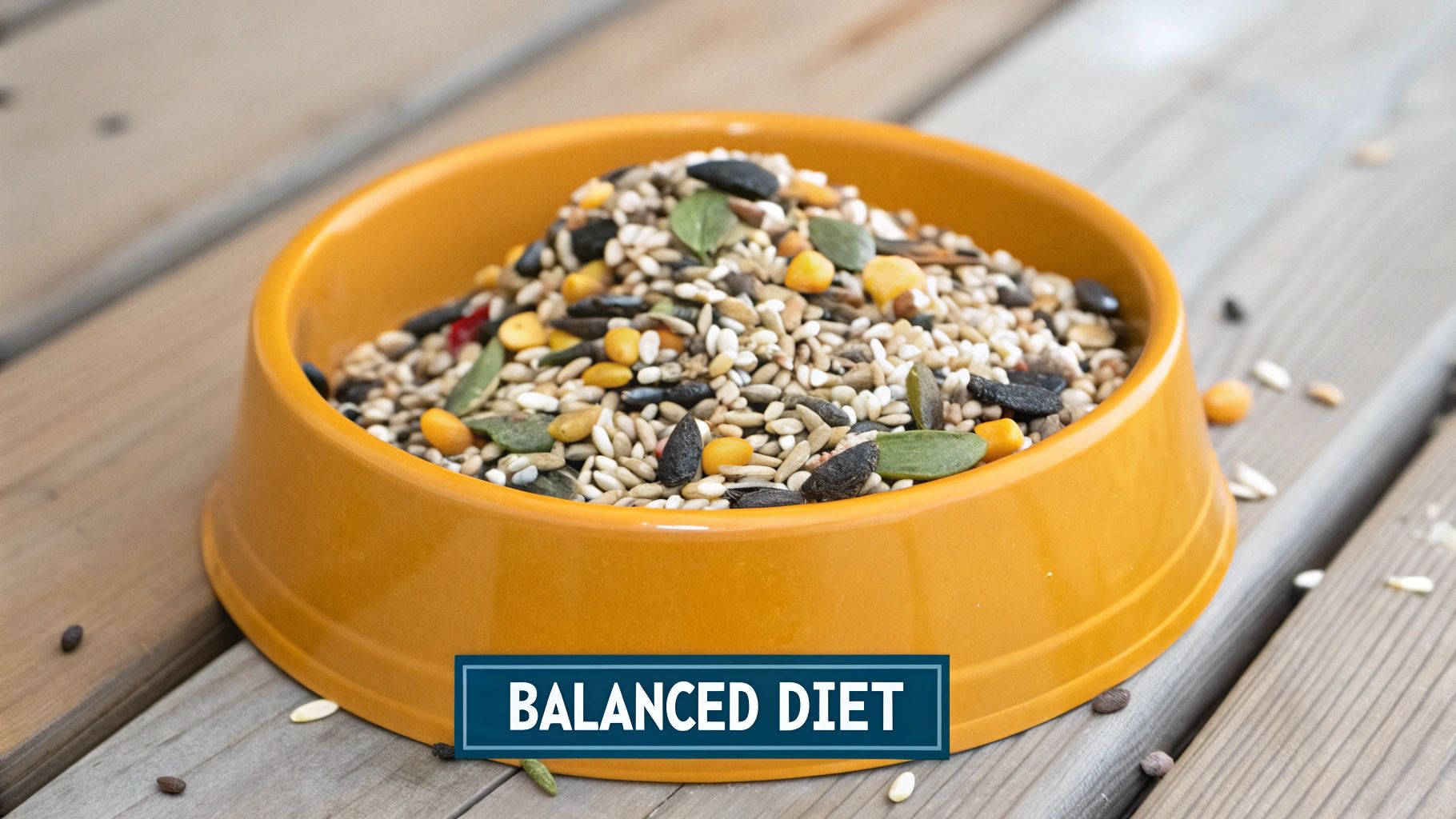
The Building Blocks of Chicken Health
A good quality commercial layer feed is much more than just a bag of mixed grains. It’s a precisely engineered diet that rests on three critical pillars: protein, calcium, and a whole host of essential vitamins and minerals.
Each of these plays a vital, non-negotiable role in a hen's well-being. If one of these is out of whack, the whole system can get thrown off, leading to problems that a few mealworms can't fix.
-
Protein The Feather and Egg Maker: Protein is the absolute workhorse nutrient. It’s critical for growth, healing, and, of course, making feathers and eggs. Did you know feathers are made of about 85% protein? This is why a chicken’s need for it goes through the roof during a molt. Egg whites are also nearly pure protein, so a steady supply is a must for a productive layer. A good layer feed typically provides 16-18% protein to keep everything running smoothly.
-
Calcium The Eggshell Architect: You can thank calcium for those strong, perfect eggshells. A hen pulls a massive amount of calcium from her body to form just one shell. Without enough of it, you'll start seeing thin, weak, or even soft-shelled eggs. That’s why layer feeds are packed with calcium and why it’s always a good idea to offer free-choice crushed oyster shell on the side.
-
Vitamins and Minerals The Unseen Heroes: These are the micronutrients working tirelessly behind the scenes. They manage everything from immune responses and bone strength to overall metabolic health, making sure all your chicken's internal systems are firing on all cylinders.
How Nutritional Needs Change with Age
A chicken's dietary needs aren't one-size-fits-all; they shift dramatically as they grow. Nailing the nutrition at each stage is the key to raising a healthy, happy flock. It’s the reason you can't just toss chick starter to a laying hen and hope for the best.
Think about it—a tiny, fluffy chick has completely different requirements than a full-grown hen laying an egg almost every day. Feeding the wrong thing at the wrong time can cause some serious, long-term health issues.
A classic mistake is giving calcium-heavy layer feed to young pullets who aren't laying yet. Their bodies can't handle that much calcium, and it can lead to kidney damage. Always match the feed to the flock's age and job!
Here’s a quick look at the different life stages:
-
Chicks (0-8 weeks): These little fluffballs need a high-protein starter feed (around 20-24% protein) to fuel their incredible growth spurt. You can also find medicated versions that help protect them from coccidiosis, a common and often deadly gut parasite.
-
Pullets/Growers (8-18 weeks): As they transition into their "teenage" phase, their protein needs dip a bit. A grower feed with 16-18% protein and less calcium helps them build a strong frame without overworking their still-developing organs.
-
Laying Hens (18+ weeks): Once they start laying, it's time for the main event: a layer feed with 16-18% protein and a big calcium boost for strong eggshells. To dive deeper into perfecting their menu, check out our guide on what to feed laying hens.
Once you have these fundamentals down, you can see why treats and snacks should only be a small, supplemental part of their diet. They're a fantastic bonus, but they can never take the place of a complete, high-quality feed designed for their specific stage in life.
Safe and Healthy Fruits and Vegetables for Chickens
Your flock will go absolutely wild for the fresh, vibrant tastes of fruits and vegetables. These natural snacks for chickens are more than just a fun treat; they're loaded with essential vitamins, minerals, and water that perfectly complement their regular feed. Think of it as giving your chickens a tiny, nutrient-packed salad bar that directly supports their immune system and overall health.
Sharing produce from your garden or kitchen is also a fantastic way to cut down on food waste. Those scraps that might have ended up in the compost bin can become a valuable nutritional boost for your birds. This small act of sustainability mirrors a larger trend in the food industry. The global poultry market is even projected to grow by 2.5% to 3% in 2025, partly because of a stronger focus on efficiency and sustainability. You can find more insights about this trend and global poultry market growth if you're curious.
Nutrient-Packed Leafy Greens
Leafy greens are a true nutritional powerhouse for chickens. They’re absolutely brimming with vitamins A, C, and K, which are vital for everything from sharp eyesight and a strong immune system to proper blood clotting. They're basically a daily multivitamin for your flock.
Here are some of the best greens you can offer:
- Kale: This one is incredibly dense in vitamins and calcium, making it a top-tier choice for your laying hens.
- Spinach: A great source of iron and antioxidants. Just be sure to offer it in moderation, as its oxalic acid can interfere with calcium absorption.
- Lettuce (dark varieties): Go for Romaine and other dark lettuces, which offer good hydration and vitamins. Iceberg lettuce, on the other hand, is mostly water and doesn't pack much of a nutritional punch.
- Swiss Chard: Similar to spinach, it's full of nutrients but is best served as part of a varied mix of greens.
You can toss whole leaves right into the run, or for a bit of fun, hang a head of cabbage from a string. This not only provides a tasty snack but also gives them an engaging activity that encourages natural pecking and helps keep boredom at bay.
Hydrating Fruits and Berries
On a warm day, nothing beats fruit. It offers a sweet taste and, more importantly, a big boost of hydration. The natural sugars provide a quick pop of energy, which can be really helpful when the sun is beating down. Because of that sugar, though, fruits should always be an occasional treat, not a daily staple.
Some excellent fruit choices for your flock include:
- Berries: Blueberries, strawberries, and raspberries are loaded with antioxidants that help protect your chickens' cells from damage.
- Melons: Watermelon, cantaloupe, and honeydew are over 90% water, making them one of the absolute best treats for keeping your flock cool and hydrated.
- Apples: A flock favorite, for sure. But it is critically important to remove every single seed, as they contain trace amounts of cyanide.
- Bananas: These are high in potassium and vitamins. You can even feed them with the peel on!
To see how different types of produce stack up, check out this quick comparison of three popular and safe options.
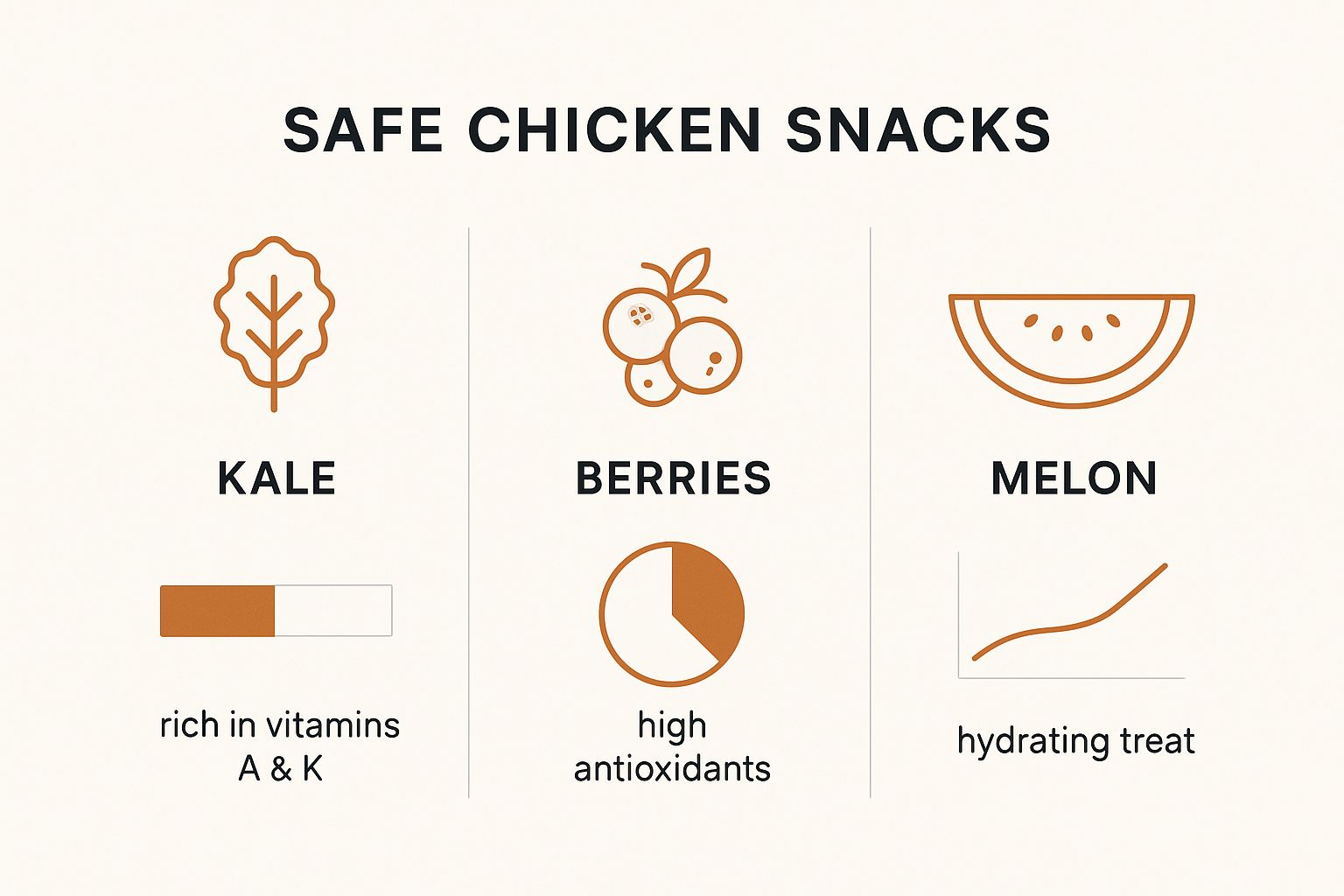
As the infographic shows, different snacks serve different purposes—from delivering vitamins to providing pure hydration.
Wholesome Garden Vegetables
A huge variety of garden vegetables can be safely shared with your chickens, giving them fiber, vitamins, and minerals that support good digestive health. These snacks also add interesting textures to their diet, making treat time much more exciting.
Remember to always chop larger or harder vegetables into small, manageable pieces. This prevents choking hazards and makes it easier for your chickens to enjoy their snack safely.
Some of the best vegetable options are:
- Cucumbers: Just like melons, cucumbers are fantastic for hydration and make for a great low-calorie treat.
- Broccoli and Cauliflower: You can serve these raw or cooked. Either way, they offer plenty of fiber and vitamins.
- Carrots: A wonderful source of beta-carotene. It's best to serve them shredded or cooked to make them easier for your flock to eat.
- Cooked Squash and Pumpkin: Both the flesh and the seeds are super nutritious. In fact, many chicken keepers believe pumpkin seeds act as a natural dewormer.
Always make sure any vegetables you offer are fresh and completely free from mold. A good rule of thumb is, if you wouldn't eat it, your chickens probably shouldn't either. By thoughtfully choosing from this wide array of produce, you can provide exciting and beneficial snacks for chickens that will have them running to greet you every time you step outside.
Boosting Protein with High-Value Chicken Treats
https://www.youtube.com/embed/4KRmEZUNwbU
While fruits and veggies are great for adding vitamins to your flock's diet, there are times when what they really need is a serious protein boost. Protein is the absolute cornerstone of a chicken’s health—it's essential for growing strong feathers, building muscle, and, of course, laying all those delicious eggs. If their protein intake dips, you'll start to see the signs: scraggly feathers, a drop in egg production, or just a general lack of energy.
This need for protein becomes especially critical during two very demanding times in a hen's life: the annual molt and the peak of her laying season. When a chicken is growing a brand-new set of feathers, you have to remember that those feathers are made of about 85% protein. Likewise, laying an egg nearly every day is a huge metabolic effort that requires a steady stream of high-quality protein to sustain.
The Molt and Its Protein Demands
Think of the annual molt as a complete wardrobe change for your flock. They ditch their old, broken feathers and invest a massive amount of energy into growing thousands of new ones to get ready for winter. This process is so draining on their protein reserves that most hens will stop laying eggs altogether until it's over.
Offering high-protein snacks for chickens during their molt is one of the best things you can do to help them through it. A good protein supplement ensures their new feathers grow in thick, glossy, and strong, giving them the best possible insulation for the cold months. It can even help speed up the molting process, getting your hens back to their happy, egg-laying selves that much faster.
Comparing Popular Protein Snacks
When you're looking for a good protein treat, it’s important to know that not all snacks are created equal. While many options provide a decent amount of protein, they can differ wildly in their overall nutritional profile—especially when it comes to calcium.
Here’s a quick look at some of the most common protein-packed options people reach for:
- Seeds: Things like sunflower and pumpkin seeds are easy to find and chickens enjoy them. They offer some healthy fats and a bit of protein, but their nutritional punch is pretty moderate.
- Mealworms: For a long time, mealworms were the go-to high-protein treat. Chickens go wild for them, but they come with a significant flaw: a very poor calcium-to-phosphorus ratio.
- Black Soldier Fly Larvae (BSFL): Often sold as dried grubs, BSFL have quickly become the top-tier choice for knowledgeable chicken keepers. Not only are they packed with protein, but they also contain up to 85 times more calcium than mealworms.
This shift toward high-quality, protein-focused snacks isn't just happening in the chicken coop. We see it in our own food choices, too. The global market for chicken popcorn, for instance, is expected to reach $5 billion by 2025, according to a market analysis from Archive Market Research. It just goes to show that everyone, humans and hens alike, appreciates a satisfying, protein-rich snack.
Protein Snack Comparison for Chickens
To make the choice clearer, here’s a table comparing popular protein treats and what they bring to the table for your flock.
| Snack Type | Key Nutrient | Best For | Considerations |
|---|---|---|---|
| Black Soldier Fly Larvae | Protein & High Calcium | Eggshell strength, molting | Premium, nutritionally complete treat |
| Mealworms | High Protein | A quick protein boost, training | Very low in calcium; can disrupt mineral balance |
| Sunflower Seeds | Healthy Fats & Protein | Energy boost in winter | Use in moderation due to high fat content |
| Pumpkin Seeds | Vitamins & Minerals | A natural deworming aid (unproven) | Lower in protein than insects |
Ultimately, while all these snacks have their place, Black Soldier Fly Larvae stand out as the most balanced and beneficial option for supporting your flock’s core nutritional needs.
Why BSFL Are the Superior Choice
The real game-changer with Black Soldier Fly Larvae, like Pure Grubs, is their naturally perfect calcium-to-phosphorus ratio. This is a huge deal for laying hens. Chickens need both minerals, but if there's too much phosphorus in their diet, it can actually block their bodies from absorbing the calcium they need.
Because BSFL provide a high level of calcium that is easy for a chicken's body to absorb, they directly support the creation of strong, thick eggshells. This helps you avoid the frustrating problems of soft, thin, or even shell-less eggs that often stem from a nutritional imbalance.
When you choose BSFL, you're giving your flock a treat that works with their main layer feed, not against it. It reinforces the very nutrients they need most for egg production and overall health. For a deeper dive, check out our guide on why dried grubs for chickens are such an incredible addition to their diet.
By adding high-value protein snacks like BSFL to your routine, you’re doing more than just giving a treat—you're making a smart investment in your flock's health, feather quality, and egg-laying consistency.
Foods You Should Never Feed Your Chickens
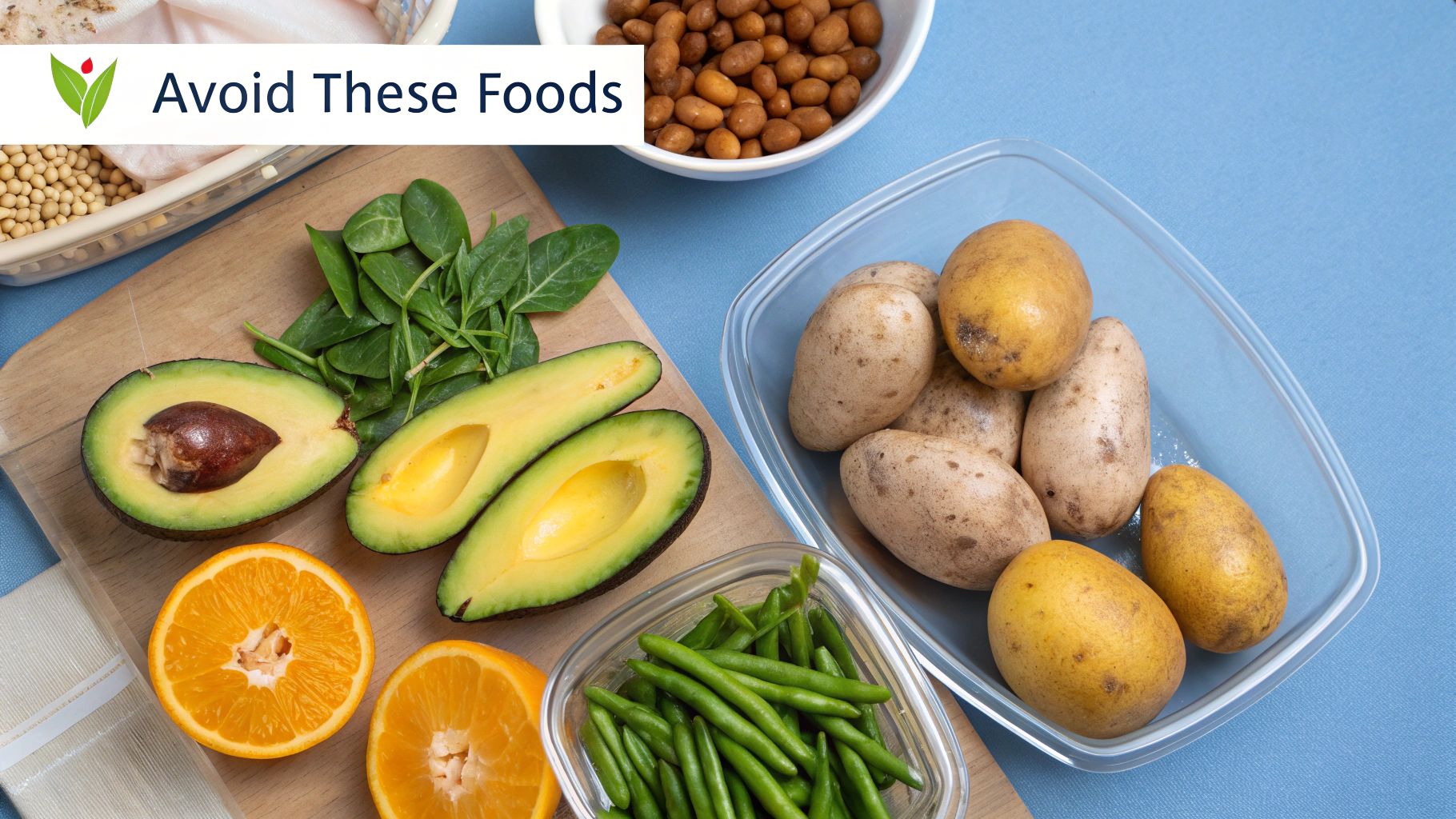
Tossing kitchen scraps to your flock is a great way to bond and provide some variety in their diet. But hold on—not everything on our plates is safe for chickens. Some of our favorite foods are downright toxic to them and can lead to serious illness or even death.
Knowing what not to feed your chickens is every bit as important as knowing what healthy treats they love. A chicken's digestive system is a finely tuned machine, built for a specific kind of fuel. Giving them the wrong stuff can cause a total system breakdown.
Common but Toxic Foods
Certain everyday foods contain natural toxins that are perfectly harmless to us but act like poison to birds. It’s critical to learn this list and make sure these items never find their way into the scrap bucket. Even a small amount can cause big problems, so it pays to be vigilant.
Keep these dangerous offenders far away from your flock:
- Avocado: The skin, pit, and even the plant itself contain a toxin called persin. For birds, this can trigger severe respiratory distress and heart failure.
- Uncooked Beans: Raw or dried beans are loaded with hemagglutinin, a potent insecticide. It causes a chicken's red blood cells to clump together, which is often fatal. Always cook beans thoroughly if you plan to share.
- Chocolate and Caffeine: These contain stimulants like theobromine and caffeine. In chickens, they can lead to heart problems, seizures, and death.
- Onions and Garlic: While a tiny, infrequent bite might not cause an issue, larger amounts can destroy a chicken's red blood cells and lead to a dangerous form of anemia.
A common mistake is thinking that if something is "natural," it must be safe. But many plants have their own chemical defenses, and what protects the plant can poison your flock.
The Dangers of the Nightshade Family
Many of us grow tomatoes, potatoes, or eggplants in our gardens. While the ripe fruits are generally fine for chickens in moderation, the rest of the plant is strictly off-limits.
The leaves, stems, and any green parts of these plants—especially green potato skins and "eyes"—are packed with a toxic compound called solanine. If a chicken eats it, solanine can cause digestive upset, nervous system damage, and even breathing problems. Never toss green potato peels into the coop or let your flock munch on your tomato plants.
Why Processed Human Snacks Are Harmful
Let's be honest: junk food is junk food, whether for us or our birds. Processed snacks, sugary sweets, and salty foods can completely overwhelm a chicken's system. They simply aren't built to handle high levels of salt, refined sugar, or artificial fats.
Interestingly, this focus on healthy, protein-first snacking is a huge trend in human food, too. The global meat snacks market is expected to hit $20.20 billion by 2034, driven by people seeking out better-for-you options. You can read more about the growth of the meat snacks market and see how it mirrors our goal of providing quality nutrition for our animals.
Feeding processed snacks can cause a whole host of problems:
- Obesity and Fatty Liver: Too many empty calories lead to weight gain and can cause fatty liver hemorrhagic syndrome, a life-threatening condition for laying hens.
- Digestive Upset: Salty foods can lead to dehydration and kidney failure. Sugary treats can ferment in the crop, causing a painful condition known as sour crop.
- Nutritional Imbalance: If your chickens fill up on junk, they won't eat their balanced feed. This can quickly lead to deficiencies in vital nutrients like protein and calcium.
By keeping these harmful foods out of their diet, you're ensuring every treat you give is actually a treat that helps them thrive.
Your Top Questions About Chicken Snacks Answered
If you're raising chickens, you've probably got questions about treats. And that's a good thing! Knowing what to give your flock, how often, and when can make a huge difference in their overall health and happiness. We've gathered some of the most common questions we hear from fellow chicken keepers to help you treat your birds like a seasoned pro.
Let's dive into the details, from treat timing to the safety of kitchen scraps.
How Often Can I Give My Chickens Snacks?
The golden rule here is the 90/10 rule. It’s a simple concept: at least 90% of your flock’s diet needs to come from their complete layer feed. That leaves just 10% for snacks and other goodies. In the real world, this works out to a small, healthy treat a few times a week, not every day.
Think of treats as a special occasion, not a daily meal. Honestly, over-treating is one of the easiest mistakes to make. It can quickly lead to problems like obesity, nutritional imbalances, and even a drop in egg production because your hens are too full to eat the balanced feed they truly need.
So, what does moderation look like? A small handful of scratch grains for a flock of five or six, or about a cup of chopped greens tossed into their run is plenty. When it comes to treats, less is always more.
Can Baby Chicks Have Snacks?
Great question, and one you need to get right. The short answer is yes, but only with extreme caution and after they've had a solid start on their proper food. For the first three to four weeks, baby chicks need to eat one thing and one thing only: their starter feed. This feed is specifically designed with the high protein and essential vitamins they need to grow strong and healthy.
Giving them snacks too early can throw that delicate nutritional balance completely out of whack. Their tiny digestive systems are still figuring things out, and filling them up with treats can prevent them from getting the critical nutrients they need, which can stunt their growth.
Once your chicks hit that one-month mark, you can start introducing very small, soft treats. Think tiny bits of scrambled egg, finely chopped parsley, or a few crumbles of Pure Grubs. Start with just a taste and see how they handle it.
Are Kitchen Scraps Safe For Chickens?
Absolutely! Many kitchen scraps are not only safe but also make fantastic, waste-reducing snacks for chickens. Leftover steamed veggies, cooked rice, fruit cores (just be sure to remove any iffy seeds), and vegetable peels can add wonderful variety to their diet. It’s a win-win: your flock gets a treat, and you reduce food waste.
But—and this is a big but—you have to be the gatekeeper. Never, ever feed your chickens anything that's moldy, spoiled, or loaded with salt, sugar, or fat. This can lead to serious digestive problems, like sour crop, where food literally ferments in their crop instead of digesting.
It’s also crucial to remember the list of toxic foods we covered earlier. Things like onions, garlic, avocados, chocolate, and uncooked beans are a hard no. My motto has always been: when in doubt, throw it out.
What Are The Best Snacks For Chickens In Winter?
Winter is a different ball game. Your chickens burn a ton of extra energy just staying warm, especially on those long, frigid nights. This is when adjusting their snack routine can really help, giving them the fuel they need to generate body heat when bugs and greens are long gone.
During the cold months, your focus should shift to high-energy and high-protein treats.
- Scratch Grains and Cracked Corn: Think of these as chicken-approved carbs. Tossing some in their run late in the afternoon gives their metabolism something to work on overnight, which helps create warmth from the inside out.
- Suet Cakes: You can buy pre-made suet cakes or make your own with seeds and grains. They provide a fantastic source of fat for energy, but use them sparingly to keep your birds from getting too plump.
- High-Protein Treats: The cold is the perfect time to up the protein. Protein is essential for overall health and maintaining good feather condition—and feathers are their primary source of insulation.
For a serious winter wellness boost, Pure Grubs Black Soldier Fly Larvae are an incredible choice. Their high protein content supports metabolic health, while the rich calcium helps ensure your hens keep laying eggs with strong shells, even when the weather is miserable.
By tailoring your treats to the season, you're not just helping your flock survive the winter—you're helping them thrive.
Ready to give your flock the ultimate high-protein, high-calcium treat? Pure Grubs offers premium, USA-grown Black Soldier Fly Larvae that support stronger eggshells, brilliant feathers, and happy, healthy chickens. Shop Pure Grubs today and see the difference!
